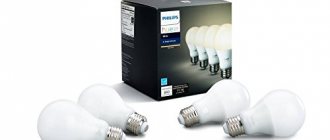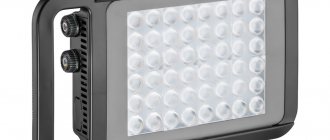From time to time, after installing energy-saving lamps, whether compact fluorescent or LED, people encounter problems such as dim glow or flickering of the lamp. Moreover, this happens when the lights are turned off, creating particular discomfort at night. This happens for various reasons. So, let's figure out why the energy-saving lamp blinks when the lights are off.
How the housekeeper works
Compact fluorescent ESLs cannot be connected directly to a 220 V network, so an electronic ballast circuit is located in their housing. The operating principle of this circuit is as follows:
The voltage from the 220 V network is supplied through a fuse to the diode bridge, after which it becomes rectified with a ripple of 100 Hz.
Further along the circuit there is an electrolytic capacitor that smoothes out ripples. Its capacity can vary depending on the power, it should be approximately equal to 1 µF per 1 W of lamp power. Next, the voltage is supplied to the self-oscillator circuit using two transistors, which contains:
- Dinistor DB3 with a switching voltage of about 30 V.
- A transformer with three windings (primary - with the largest number of turns and two base - a pair of turns each). It is wound on a ferrite ring with an internal diameter of about 3–5 mm.
- Two transistors type MJE13001–13003.
This circuit operates at a frequency of several tens of kilohertz.
The output part consists of a pair of capacitors and a power choke, usually wound on an W-shaped ferrite core.
The output circuits of the circuit are connected to the lamp coils.
The light-emitting bulb itself is a glass tube. It is filled with mercury vapor and coated on the inside with a phosphor.
Scheme of operation of an energy-saving lamp
Blinking light when the switch is on
If the switch is in the active state, two reasons for the blinking can be distinguished:
- Low tension. Any light source is sensitive to low voltage. If a high-quality driver is installed in the LED bulb, stable operation can be achieved at 180 V. Lamps without a high-quality driver turn off already at 200 V. Flickering at voltages below 220 V will be observed at different frequencies and will stop when normal operating values are reached.
- Poor quality power supply. If the mains voltage is normal, the problem may be related to the power supply. The use of low-quality elements will not allow the device to equalize the current and bring the values to the optimal level.
The malfunction also appears when dimming a light bulb that is not designed for this function. Then the user will observe flickering when the brightness is lowered. Stable operation without pulsation will be noted if you turn on the lamp immediately to maximum brightness. The unsuitable lamp must be removed and a special dimmable light source installed.
There are two ways to identify the cause of flickering when it is turned on:
- Using a pencil. In a completely dark room, only the lamp being tested should be turned on. You need to quickly draw a pencil in front of it. If there is a continuous trail behind it, there is no flicker. If the trace is intermittent, pulsations are present.
- Test with a camera on a smartphone. You need to turn on the light bulb and point the camera at it at a distance of about a meter. When flickering occurs, dark streaks will appear on the screen. If there is no blinking, the image will be uniform and of the same color.
The LED lamp flashes after switching on:
- In case of voltage surges, a stabilizer is installed. It brings the current to the required parameters and at the same time prevents premature breakdowns of electrical appliances.
- The power supply can be upgraded independently. To do this, you should select a high-quality smoothing capacitor and place it in the circuit.
Users with electrical engineering skills will be able to make a reliable driver themselves.
List of possible causes
The power supply circuit for an energy-saving lamp is quite complex, which is why the blinking occurs. However, fixing this problem is very simple. But first, I propose to understand the reasons.
Backlight on the switch
Some switches are equipped with backlighting, usually a neon indicator or LED. It is needed so that you can more easily find the switch in the dark, and it only lights up when the lamp is turned off. To light the indicator in the switch, a small current is needed; when incandescent lamps were used, this current passed through the circuit: phase wire - indicator - lamp - neutral wire. This current did not affect the lamp, no one asked this question. When they started using energy-efficient light sources, the problem of flickering arose.
The current flows through the indicator to the input of the electronic ballast, through the diode bridge it charges the smoothing capacitor, when the voltage on its plates reaches the required value - the circuit turns on and the light bulb begins to glow, this period is very short, and you only see a flash.
A similar situation occurs with LED devices.
The backlight on the switch is a useful feature, but can lead to malfunction of energy-saving bulbs
Electrical wiring problems
The condition of the electrical wiring also affects the flickering of energy-saving lamps. Old wiring is likely to have poor insulation, allowing small currents to flow between the wires and to the switch. As a result, current flows “past” the switch. Next, the process of charging the capacitor and flashing the light occurs as described above. This is called current leakage. In addition, the flow of unnecessary currents can be affected by the humidity of the walls; through wet walls, the phase flows through the lamp to zero or ground. And the third reason may be the large length of the cable, due to which parasitic capacitance occurs. A capacitor is two conductive plates separated by a dielectric; in this case, the role of the dielectric is played by insulation. In alternating voltage, unlike direct voltage, currents flow constantly through the capacitor.
Poor quality lamp
The reason may lie not only in the external components, but also inside the lamp itself. In high-quality luminaires, the circuit has filters and other means of reducing the influence of various interference on their operation. Do not buy cheap Chinese lamps, they not only have a lot of disadvantages (pulsation, low color rendering index, etc.), but are also generally dangerous. In any case, for normal wiring, use a switch without backlight.
Make sure to choose a quality lamp
Why are the lights blinking in the apartment?
Finding out the reason for the blinking lights in an apartment is not always quick and easy. This is due to the inaccessibility of some junction boxes and electrical circuit elements. Even a minor malfunction of any electrical wiring element can contribute to an emergency situation that can have serious consequences. There are several obvious reasons why the lighting fixtures in the room could flicker:
- an accident at an electrical substation, resulting in unstable voltage being generated in the network;
- damaged lighting device, it could be a lamp, lamp, etc.;
- broken light bulb;
- malfunction of an outlet or a whole group of them;
- poor contact between the wire connections in the junction box;
- damage to equipment in the input panel that supplies the entire room;
- a malfunction in the apartment panel - a problem with circuit breakers or fuses;
- wear and tear of electrical cables laid indoors;
- violation of connecting contacts in electrical wiring;
- Also, the lighting may flicker due to connection to the same network with your welding machine, which creates a voltage drop during operation.
There are many other factors that influence the problems described. Let's take a brief look at the most common reasons why light bulbs blink in a room.
Precautionary measures
Every person who encounters this kind of problem and decides to independently figure out the cause of the malfunction must remember the danger of electric current. If you do not have basic skills and understanding of electricity, and do not have the necessary tools to carry out the work, you will have to use the services of a qualified electrician.
Electric current is dangerous because it is invisible to the human eye and many are not afraid of it. Each person has a certain body resistance, and it is different for everyone and depends on many factors. This may be due to lack of sleep, alcohol consumption, nervousness, high environmental humidity, etc. In such cases, it is better not to carry out work related to electricity.
Power problems
First of all, you need to find out whether the power supply in your premises is of high quality. Problems of this kind can be the source of flickering lights. This is facilitated by voltage instability in the electrical network, namely its frequently changing value. In addition, flickering light can be the result of a lamp failure, as well as any household electrical appliance that has been exposed to voltage surges.
Increased voltage in the electrical network
During short-term fluctuations, electrical devices may not suffer any noticeable damage to their operation; this depends on the protection installed in them. Do not forget that as a result of voltage ripples, a powerful surge can occur, and then the likelihood of emergency situations in electrical networks increases significantly. If such situations arise, the correct solution would be to completely de-energize the room from the incoming voltage and turn off all household appliances from the network. This will help avoid their failure.
The most common case is a contact failure of the neutral conductor connection on an overhead line support. This factor affects lighting pulsations. This will happen until the contact disappears completely, and then a phase imbalance will occur due to load asymmetry. The imbalance is directly proportional to the difference in loads on each phase, as indicated by the low and high voltages of consumers located on different lines.
Lack of contact on a power pole
In the absence of installed overvoltage protection and untimely shutdown of household appliances, the latter can quickly fail. It is important to know that some household electrical devices are not designed to operate with reduced voltage, which can also affect their functionality.
Flickering light bulb in a lamp
In this case, you need to decide whether this is happening with one lamp or with a whole group, and check the rest of the lighting fixtures. If the remaining lighting elements are operating normally, we can conclude that the lamp, lamp or other electrical wiring sections, for example, a switch, are faulty.
If the switch is not working properly, you can hear a characteristic crackling sound inside its housing. This means that it has weak contact. It does not necessarily mean that it is no longer usable. You can tighten the screws that tighten the wires. It often happens that debris gets on the spring or the contacts themselves. In this case, you need to unscrew the light bulb and try to turn the switch on and off repeatedly; the dirt may come out on its own. Otherwise, you will have to remove it and clean it, observing safety precautions.
Switch inspection
If these steps do not help, you should replace the lamps with new ones. If the lighting continues to pulsate, there are two options for solving the problem: check for serviceability of the fixtures of the lighting fixture and the electrical wiring as a whole. If you have no experience in disassembling lamps, it is better to contact a specialist.
If you decide to fix the problem yourself, you must first turn off the power to the light source. First of all, the integrity of the light bulb socket is checked. Its contact plates should not be burnt and, in normal operating condition, slightly bent. Having disassembled the cartridge, you can see the connection of the wires using screws; the contact may have been broken in this place. In this case, they are tightened.
After inspecting the lighting device, it is necessary to apply voltage and check its operation. If the light flickers again, the solution may be to check the connection of the wires of the lamp with the cable powering it. To do this, we again de-energize the line and carry out repairs.
Flickering of a lamp connected to an outlet
In this case, it is necessary to check the serviceability of the lighting device by connecting it to another outlet that is working. If everything is fine, then the original outlet is faulty. If the result is unsatisfactory, it is necessary to check the lamp and its switching equipment. The audit is carried out according to the above principle.
Broken socket
Repairs to the outlet should only be performed after the voltage on this line has been removed. After this, you should loosen the tightening screws holding it in the installation box. And conduct a visual inspection. If everything is in order, tighten the tightening bolts, thereby ensuring reliable contact. If the socket continues to perform unsatisfactorily, it will need to be replaced with a new one.
Old electrical wiring
After determining the serviceability of the lighting fixtures and normal power supply, the next step is to check the electrical wiring for integrity and quality. Cases have become very frequent in houses that were built several decades ago. They experience a certain shrinkage and partial destruction, which can affect the integrity of the electrical wiring; temporary wear of the power cables and disruption of their contact connections in distribution boxes occur.
To check the contact in the junction box, it is necessary to de-energize the line and de-insulate the wires where they are twisted. After visual inspection and detection of weak contact on the twist, it is necessary to retighten it. If it is burnt, clean it. If the condition of the distribution boxes is satisfactory, you should check the connection points of the wires in the distribution panel to the circuit breakers and the zero strip. The first step is to check the tightening of the screws on the machines. If there is poor contact, tighten it.
Broken electrical cable
The most rare cases are violations of the electrical wiring itself. This is especially true for aluminum wires due to their fragility and ability to break if bent. During the installation process, one of the cable cores may be damaged, and under the influence of electrical load, heating will occur in this place. As a result, the circuit may disappear completely, and even worse, a short circuit may occur and the wiring may catch fire.
The solution to this problem is to replace the electrical cable in the faulty section of the electrical circuit. If these actions are not possible, for example, due to recently completed repairs, you can use a bolted connection at the rupture site.
Partial replacement of wiring by extending a piece of wire is not recommended. This is due to the fact that over time, under the influence of load at the junction, weakening of the contact may again occur with all the ensuing consequences. This type of repair is allowed if low-power lighting is used in the line. Connecting a power outlet is highly not recommended.
Eliminating the cause of the problem
The problem of lamp flickering can be solved without the involvement of specialists. To do this yourself you will need a small set of tools:
- Screwdriver.
- Voltage indicator (indicator screwdriver).
- Wire cutters.
- Heat shrink.
Removing the backlight
The most radical and reliable way to eliminate outbreaks is to remove the source of the problem completely. To do this, use a thin slotted screwdriver to remove the keys from the switch. After this, follow the instructions:
- Make sure that the lamp is de-energized using a voltmeter or phase indicator; it is better to turn off the circuit breaker.
- Unscrew the screws securing the switch.
- Remove it from its seat.
- On the back side there will be a small box in which the backlight is located.
- Remove the backlight.
- Otherwise, look at how the indicator is connected and break its power supply circuits.
- Ready!
Read also: How to melt steel at home
Leave the backlight on while changing the power circuit parameters
Another way is to solder a higher resistance resistor to power the indicator and a 1n4007 diode.
Soldering a resistor into the circuit is one of the options for solving the problem of flickering light bulbs
As already mentioned, there is either a neon bulb or an LED installed there. For an LED, the resistance is about 500 kOhm, for a neon - 200–300 kOhm. The diode will cut off one half-cycle of the supply voltage. This modification will generally eliminate flicker. The difficulty is that the backlit board is quite small, so you need to be able to handle a soldering iron and small components. If you are not satisfied with this option, move on to the next one.
We create a circuit with lower resistance parallel to the lamp
When you don’t want to remove the backlight because it’s convenient and you’re used to it, you can find another way out of the current situation. To do this, you need to give the current a path to bypass the lamp. Buy a resistor (another name is resistance) at any radio parts store with a power of 2 Watts and a nominal resistance of 50 kOhm (thousands of Ohms).
Now it needs to be connected in parallel with the lamp. You can do this either in the distribution box, connecting between the phase coming from the switch and zero, or in the body of the chandelier or sconce itself, where the flickering lamp is installed.
Conscientious manufacturers install this resistor on the electronic ballast board inside the ESL, and it does not blink with such a switch. Well, cheap Chinese brands rarely take their products so seriously.
Why does the light blink when connected correctly?
If all connections are correct, check that the electrical wiring is installed correctly. The switch must open the phase wire. When your zero opens, the ESL may blink. In this case, you need to reconnect the lamp in the distribution box, connect the zero directly to it, and connect the phase to the switch; in some cases, you may need to re-lay the cable.
Incorrect wiring may cause lamp problems
It's another matter if the light bulb is located at a great distance from the switch and junction box. EMF can be induced on the supply wires. It often causes flickering. The source of interference can be nearby cables and various gadgets that use radio transmission and wireless technologies, as well as any other sources of alternating magnetic field.
Safety precautions
This is not so important for you in everyday life, so you need to adhere to the following rules:
- Turn off the voltage completely - open the circuit breaker at the entrance to the apartment.
- Do not work if the environment is humid, this means both water on the floor and wet walls.
- Use tools with handles insulated with dielectric material.
By following these three simple tips, you will save your health and life.
In the modern world, users are increasingly using their energy-saving “sisters” instead of conventional incandescent lamps. However, along with convenience and savings, unexpected problems arise during the operation of such electrical appliances. Among such “surprises”, the blinking of a lighting device after being turned off is often mentioned. Why do energy-saving light bulbs blink? Let's figure it out.
Independent search for the cause of the malfunction
If an energy-saving lamp used in a lamp or other product begins to blink, then you need to start fixing the problem immediately. Since each lighting device has resource limitations in terms of the number of starts.
That is, each such cycle reduces the operating time, and if they are repeated frequently, then in just a few days the service life will be reduced by many months, or even years. In addition, as mentioned above, if the wiring is faulty, there may be a threat to the health of the home owner, his family and friends, which should not be allowed.
Troubleshooting should only be carried out by a trained technician, using a special tool in compliance with all safety measures provided for in the governing documents.
The troubleshooting procedure should begin with the simplest methods that do not require costs. And if they don’t give results, then move on to more complex ones.
So, first of all, you need to check the functionality of the light bulb itself. Why can it be moved to another place, tested with neighbors and acquaintances. If the blinking continues, then you just need to replace the lighting fixture.
When, after installing the lamp in a new location, the malfunction does not appear, then the switch should be replaced. In order not to waste money, you can take it from another place for testing and, preferably, it should be without a backlight. When the cause is identified, you should simply buy and install a new switch.
If this does not produce results, then the owner of the premises should look for a problem in the wiring. But when performing any electrical work, it is important to remember that all of it is potentially dangerous. Therefore, you need to follow measures to prevent and avoid risky situations, have sufficient skills and have the appropriate tools.
The information in the following article will help you find out the reason why the LEDs glow after disconnecting from the power supply.
How it works? Difference between different types of lamps
As you know, manufacturers produce several types of lamps. Until recently, the most famous and widespread were ordinary incandescent lamps. Such a lighting accessory emits light due to very strong incandescence, heating of a special wire inside a glass bulb. It is called the "filament".
There are also fluorescent and energy-saving light bulbs. There is no filament in such lighting fixtures. The operation of such lamps is carried out due to the formation of a potential difference. In this case, electrons flying inside the device in the gas cause it to glow.
Before we begin to understand why energy-saving light bulbs blink, let’s determine what conditions they have.
- There is no power to the lamp and it is turned off.
- There is a slight voltage coming to the light bulb. Sometimes it may be a small amount of current, too small to start it. In this case, the capacitor is gradually charged. When sufficient voltage accumulates, the light bulb turns on briefly. However, the capacitor is instantly discharged, and the device immediately goes out. This process looks as if an energy-saving light bulb is blinking.
- When sufficient power is supplied for normal operation of the lighting fixture, the light bulb turns on. The device serves to perform its main function - illumination of a room, objects, area, etc.
Now that you have become a little familiar with the principle of operation of energy-saving light bulbs, you can begin to understand why energy-saving light bulbs blink.
How to deal with blinking? Method one
We previously wrote about why a switched off energy-saving light bulb blinks. At the same time, the incandescent lamps screwed in instead of the housekeepers do not blink. Therefore, the simplest solution would be to replace energy-saving lamps with their “sisters” with filament. However, with this option you will have to forget about economical consumption of electricity.
Read also: Do-it-yourself plasma torch, diagrams and drawings
Of course, you can pick up several low-power lamps. However, in some cases, such a solution is not very rational (for example, there is only one lamp horn in the lampshade, but you don’t want to use a lamp that is too powerful). Now that you understand why energy-saving light bulbs blink, you can add one more touch to them: solder a 10-20 kOhm resistor in parallel with the socket. This element will “pull back” the small current that caused the blinking.
Conclusions.
Thus, almost any flicker can be eliminated. Although it is more practical to prevent its occurrence in advance. An important factor in this case is the choice of high-quality light sources and control equipment. In this case, the possibility of humming and flashing is minimal.
- Related Posts
- Do-it-yourself outdoor lighting: plan, installation, connection, selection of equipment and repairs
- LED lamps with motion sensor: popular manufacturers, scope of application, setting parameters
- Types of lighting, fixtures and lamps for the bathroom
The second way to deal with blinking
If you have exactly this situation, there is a need to reconnect the zero and phase on the lighting group in the panel if such phenomena occur throughout the house or apartment. The situation may turn out to be simpler - sometimes it is enough to restart the circuit, only in a certain junction box.
Before performing any actions, you need to make sure that your switch actually opens not the phase wire, but the neutral one. To carry out such manipulations, it is enough to use the indicator. You just need to touch each of the wires connected to the switch.
When your indicator does not show the presence of voltage (while the indicator itself is working), then in this case the real reason is a broken neutral wire. It is necessary to reconnect it in the distribution box or switchboard. Now you already know exactly what to do if the energy-saving light bulb blinks after being turned off.
Another way to deal with blinking
Sometimes it is enough to swap incandescent light bulbs from one room with “housekeeper” lamps from another. As they say, “cheap and cheerful.” Screwing at least one regular incandescent lamp into a multi-arm chandelier along with energy-saving light bulbs can also help. It is important to place it in a cartridge that can be turned off using a backlit key.
Why does the energy-saving light bulb blink? Is it harmful?
First, determine whether you are a nervous person. For many people, a flashing energy-saving light bulb gets on their nerves. In the dark, such blinking can scare not only younger family members, but also adults. Many users, when faced with this problem for the first time, are seriously scared, thinking that the problem is faulty wiring. Some are afraid of a short circuit and, as a result, a fire.
Reasons for mandatory elimination of lamp blinking
When the lights are turned off and the light bulb blinks at night, everything must be done to prevent this from happening again. Flickering needs to be eliminated for the following reasons:
- There is a constant disturbance of human peace.
- The service life of the lighting device is reduced. As a result, the lamp service life is reduced significantly. And even the high performance and long service life praised by the manufacturer will not help. The average service life of an LED or fluorescent lamp is almost 10 thousand hours (plus/minus a few hundred more hours). Such a long period of operation is determined by the fact that the LED consumes significantly less electrical energy. But if the lamp constantly blinks, then the operating life will be 4-5 thousand hours or less. An important factor here is the quality of the lamp and the manufacturer.
- Unsafe for the living space and its occupants. At any moment, a short circuit in the electrical network can occur, which often provokes a fire, ignition and ignition in the wiring.
Therefore, when faced with such a problem, you need to try to simply replace the lamp and see what happens. If this does not help, then there is no point in dealing with the wiring and electrical panel without special skills and tools. Among the basic safety rules that must be followed, first of all it is worth noting the following:
- turn off the electrical power at the panel to protect the residents of the apartment or house;
- call an electrician;
- warn neighbors on the landing that similar problems are observed and therefore wiring repairs will be carried out.
Thus, flashing of the lamp after turning off is common. It is possible to solve this problem, but to do this it is necessary to establish the true cause of this phenomenon. If you cannot cope with the consequences of flickering LED lighting on your own, then you need to seek qualified help.
Afterword
It is of great importance which manufacturer you prefer. Many people purchase cheap energy-saving light bulbs, guided by the principle “saving means saving on the purchase price.” You should know that well-known companies are trying to produce products not only of higher quality, but also more advanced ones. This also applies to energy-saving light bulbs.
Most cheap lighting products are made from low quality raw materials. As a result, the service life of such products is short. Energy-saving light bulbs made from higher quality and more expensive raw materials will not only be safe for you and your family. They will last much longer - the service life of products manufactured under well-known brands can last five to eight years. Now think about it: is it really more economical to buy several light bulbs during this period, or is it more profitable to buy one expensive, but high-quality one? The conclusion suggests itself.
Now that you know why the energy-saving light bulb blinks and what are the ways to solve this problem, all you have to do is start taking action!
Most users in their homes have already replaced conventional incandescent lamps with energy saving ones. However, when purchasing economical lamps, you have to deal with an unusual phenomenon.
It turns out that energy-saving and LED light bulbs in chandeliers and lamps begin to blink with weak flashes (even when the lighting is turned off). This is especially noticeable indoors at night. However, when replacing an economical lamp with the most common incandescent light bulbs, the phenomenon immediately disappears.
It all started when a neighbor came to me and started complaining that the store sold him defective energy-saving lamps. Yesterday he says he bought and installed five light bulbs in a five-arm chandelier. They work great, they shine well, but in the evening when I was getting ready to go to bed, I turned off the chandelier and I was sleeping, talking like I was at a disco, all these five lights blinking periodically.
What could be the reason? We came to his house, and indeed, when the chandelier is turned on, the lamps shine normally, but when the switch is off, they begin to blink, and that’s it. Well, I think there might be a bad contact somewhere in the chandelier or something else.
After examining all the contact connections of the chandelier, everything was in order, no questions arose at all. But there was one point - the switch was with LED backlight. So, why does the energy-saving lamp flicker after being turned off? Let's find out in this article.
What should I do if the lamp flashes when the lights are off?
There are several ways to solve the problem with the switch:
- the energy-saving lamp is replaced with a regular one;
- remove the backlight in the switch, but to do this you will need to call a technician to break the power circuit in the device;
- install a regular switch.
Improper installation of the structure and poor-quality products are the second most important reason why the light bulb blinks. This happens because the switch breaks the zero phase, and not the one that is needed. If a person understands electrical wiring, then he can solve the problem himself. But it’s better to call an electrician to prevent a short circuit. The master must change the zero phase to the desired one, which will eliminate blinking.
An electrician must have easy access to the electrical panel and wiring. But before you get into the panel or switch, you should just change one lamp for another. LED blinking is often caused by the fact that the lamp is broken, faulty or of poor quality. To avoid this, it is recommended to buy lighting sources in specialized stores that sell certified products. You should not purchase products from an unknown company. If the requirements for the lamp do not meet the standards, then problems will arise with the LEDs blinking from time to time when the light is off.
When buying LED or fluorescent light bulbs, you should pay attention to factors such as:
- Manufacturing company. You need to refuse cheap Chinese counterfeits.
- The integrity of the package in which the lamp is located.
- Check the LED in the store to make sure the product is in working order and of its quality.
Designers and lighting experts recommend choosing energy-saving lamps for living rooms that provide warm light. But for non-residential premises, LEDs that produce cold light are best suited. Lamps such as compact fluorescent lamps are highly valued on the market for their quality and performance.
In any case, one or another reason causing the LED to blink must be resolved by professionals. Electricians often advise which lamp company should be chosen to fix problems in the house. Some people who are faced with blinking light bulbs recommend reading on the Internet what to do in such situations. But not all the advice that is available online is effective and safe for non-electrical technicians.
How modern energy-saving lamps work
We’ll look at the question of why a switched-off energy-saving lamp blinks a little later; now we’ll figure out how modern energy-saving lamps work.
Did you know that, unlike incandescent lamps, fluorescent and LED lamps operate from a constant power source, that is, they operate at a constant (rectified) voltage. How can you ask? After all, the lamp is supplied with an alternating voltage of 220 V; there are no rectifiers in the sockets or chandeliers. I assure you, there is, and this rectifier is located inside any modern lamp.
Read also: Resanta sai 220pn circuit diagram and malfunctions
Inside each energy-saving lamp, between the base and the tube, there is an electronic board (in professional language they are called electronic ballasts), thanks to which they work.
An alternating voltage is supplied to the input of a special rectifier (diode bridge), and at the output we have a constant or rectified voltage.
I will not go into all the details of the operation of these circuits, but in order to smooth out the ripples, a special smoothing capacitor is installed. It is precisely because of this capacitor that the energy-saving lamp blinks. And in what case this happens, and under what circumstances, let's look at it below.
Other reasons
Sometimes the light may blink due to a breakdown of an energy-intensive electrical appliance. For example, the heating element of a water heating boiler can partially penetrate the grounded body, while remaining in operation. As a result of such a hidden fault, the voltage in the house becomes unstable and the light bulbs flicker. It is also possible that the electrical appliance is working properly, and the reason lies in a weak connection between the plug and socket contacts.
Read also: What parts does the active part of a transformer consist of?
If the light in the room blinks at a frequency of 100 Hz (noticeable with peripheral vision), then the lamp is connected through a semiconductor diode. This is one of the ways to extend the life of a light bulb and save energy, used in corridor lighting. This flashing light is absolutely safe from an electrical point of view, but is contraindicated for vision.
Changes in the electrical network can be caused by a malfunction in the main section or transformer substation. In this case, the lights flash in all apartments and houses connected to this area. The solution to this problem should be handled by the local emergency power service.
The secret of the long blinking of lamps in apartments and houses located in the private sector is revealed simply. Carrying out welding work using an old-style welding machine leads to severe voltage drops in all nearby energy consumers. It happens that it is useless to prove to your welder neighbor that he is wrong. Then it is better to buy a powerful stabilizer that can protect all electronic equipment, and replace conventional light bulbs with LED ones.
If the house is lit exclusively by fluorescent and LED lamps, then power surges may go unnoticed. High-quality CFL and LED lamps operate stably at low (high) voltage. Flashing of an LED lamp can only appear in two cases: when it is turned on via a dimmer and in the absence of a built-in current stabilizer that maintains a stable glow at a network voltage below 200V. You can learn more about blinking LED lamps in this article.
Something incomprehensible to me began the other day (no boom boom in electrics).
In the kitchen, the light bulbs in the chandelier (energy-saving) are blinking,
Sometimes one or the other goes out completely.
In the toilet, the light bulb (ordinary one) is also acting up and cracking.
If you turn the oven on and off, the lights blink in unison with this action.
Bathroom, closet and kitchen, in a machine, on a separate RCD (residual current device).
This has never happened before; the light bulbs have not been changed for a long time.
What could this be and how to solve this problem?
If the light bulbs in a chandelier blink in harmony, then the reason is a poor contact in the power supply circuit of the chandelier, most likely (in my experience) that there is a poor contact in the switch of this chandelier.
If an energy-saving lamp blinks or goes out independently of the others, then it is most likely that it is faulty. Screw it into some other lighting fixture; It is desirable that the lamp be in the same position as it was in the chandelier. Give the lamp a long test (so that it has time to warm up). To be more sure, change the location of the lamp once or twice.
An ordinary light bulb (incandescent lamp) can continuously crackle due to the fact that the tungsten filament is broken (burnt out) and the current flows through the spark gap. Such a light bulb cannot work after being turned off. There may also be sparking in the lamp socket; in this case, you need to screw in the light bulb until the sparking stops.
The brightness of the light bulbs depends on the amount of voltage supplied to them, and turning off and turning off any electrical appliance powered through common wires affects this voltage, sometimes to such an extent that we notice a change in brightness. In accordance with the Soviet standard, the consumer must be supplied with a voltage of 220 volts with a permissible deviation, if I am not mistaken, from minus 10 to plus 5 percent. So a slight change in the brightness of the light bulbs due to changes in the network load is inevitable.
Read also: Safety cord for a mounting belt
In the internal electrical panel, the electrical wires branch out and pass through different residual current devices (RCDs), but before this panel the wires are common to the entire apartment, in addition, another RCD is installed outside the apartment. Therefore, a change in the load in the circuit of one RCD affects the voltage in the circuit of another RCD.
From the point of view of the management company to which management of the house has been transferred, any resident of the house is considered a non-specialist in the field of electrical energy, so official advice can only be advice to invite an electrician to find and eliminate the causes of faults.
I encountered this especially often at the dacha. So it seems to me that there are several reasons for this.
Author of the publication
Beard
Achievement received 12/04/2018
Why does a switched off energy saving lamp blink?
Let's return to the first section of the article, with a neighbor, a backlit switch and energy-saving lamps. I would like to draw your attention to the backlit switch, since the problem is why the switched-off energy-saving lamp blinks precisely in it.
What physical processes occur in illuminated switches? When the switch is turned on, its power contacts are closed. When the switch is in the off position, the lamp in the backlight lights up (because that’s why it’s installed there).
And if the lamp is lit, then an electric current flows through it, which moves along the following path: network - backlight lamp - chandelier with a lamp - network. This current is very small (about hundredths of an ampere) and does not affect the overall network load (the electric meter does not respond to it).
The current flowing through the backlight serves as a charge for the capacitor in the electronic circuit of the light bulb. As soon as it receives a sufficient level of recharging to turn on, the circuit starts up, which is why a flash is produced. Further, after a short flash, the capacitor is immediately discharged, and the process is repeated again.
When using a backlit switch, there is a flickering effect that bothers everyone so much. Therefore, when a backlit switch and a compact fluorescent lamp are used, this flashing effect occurs. You turn off the switch, the light in the key lights up and the lamp begins to flash periodically.
| The negative aspect of all this is that the circuit inside the lamp is designed for a strictly timed resource in terms of the number of starts. Thus, the internal reserve inside the lamp is used up within 1-2 months, after which it can be safely thrown into the trash. |
A similar situation is with low-power power supplies for LED strips. “At the input” of the source, exactly the same diode rectifier and capacitor are provided.
Accordingly, a small compensating current flows in the backlit switches, and the capacitor has time to recharge. In this regard, the switched off LED strip begins to work in smoldering mode with periodic flashes of light.
| PS Self-respecting manufacturers provide the consumer with the following information on the packaging: “not for use with backlit key switches, photocells, brightness controls, dimmers, timers, etc.” Remember, these devices force the energy-saving lamp to work in critical (abnormal) mode! |
How to eliminate the cause of blinking energy-saving lamps
- 1) Probably the simplest solution would be to remove the backlight. To do this, open the switch cover and disconnect the wires that power the backlight. Or you can simply cut this wire (do not confuse it with power wires).
In this case, when the switch is turned off, the current that recharges the capacitor will not flow accordingly - the lamp does not blink.
- 2) Do not use a backlit switch. Replace all backlit switches with regular ones where energy-saving lamps are used.
- 3) Connect a regular incandescent lamp in parallel with an energy-saving lamp. This method allows you to eliminate the blinking of energy-saving lamps, since the current that charged the capacitor will go to the filament.
But I believe that this method does not really have a place to exist, since the point of all this saving and modernization. Moreover, there is not always room in the lamp to install an incandescent lamp next to an energy-saving one. But that's my personal opinion.
- 4) There are switches in which the backlight is an integral part, for example, it works as a decorative element. What to do in this situation?
If an energy-saving lamp blinks after being turned off , one way to solve the problem is to connect an additional resistance (resistor) in parallel with the lamp.
The resistor should be 2 W with a nominal resistance of 50 kOhm. The cost of such a resistor is a penny, about 10 rubles. You can purchase it at any amateur radio store.
This resistor does not affect the normal operation of the lamps in any way, but when the switch is turned off, that is, when the backlight is on, this resistor will consume the current that recharges the capacitor in the lamp starting circuit.
For safety, we insulate the resistor using heat shrink tubing. The connection can be made in the ceiling lamp, junction box or at the lamp socket itself. To connect such a resistor, you can use special Wago terminal blocks.
After connecting, carefully place the resistor in the box. The entire reason for the flickering of the energy-saving lamp has been eliminated. See you in the next lessons. I hope this article helped you understand the question of why the energy-saving lamp blinks after being turned off. Subscribe to the YouTube channel.
How to find the reason correctly?
Each user must remember that prompt action to eliminate blinking is very important. Since any LED lamp has a turn-on life, which can be used up in just a few days.
In addition, if the wiring or its insulation is damaged, there may be a danger to human health.
The presence of several cables in one groove can lead to induced voltage. The impact of wiring designed to power a powerful electrical appliance is especially strong.
The search itself must begin by checking the correct connection of the phase wire. It should always be connected to one of the switch contacts.
If it turns out that the current is approaching the backlight lamp, then this will be the cause of the blinking. The check can be done using an indicator screwdriver, which anyone can do.
When this stage has been completed and the malfunction has not been eliminated, you should replace the switch with a similar product without backlighting, install a low-power resistor, or use an incandescent lamp. If the flickering has stopped, then we can assume that the person has completed the task.
The most effective way to prevent flickering is to purchase quality lamps. If you don’t want to spend money, then you need to check for hidden flicker in the cheap analogues you buy. What can be done by quickly moving an ordinary pencil, if the silhouette does not begin to double, then the lamp is not prone to blinking
But, when the problem manifests itself again, you should inspect the wiring in order to identify damaged insulation, oxidized contacts, power cables laid nearby and other problems.
Which will need to be eliminated even if such operations turn out to be labor-intensive and expensive. Because only this can guarantee that there is no danger to human health.
If flickering occurs when the switch is in the on position, then the voltage and its stability are initially checked.
When the parameters are normal, you should replace the LED lamp with a high-quality analogue from a well-known manufacturer. Which are high-tech products from OSRAM, Philips and a number of others.











